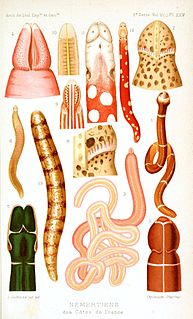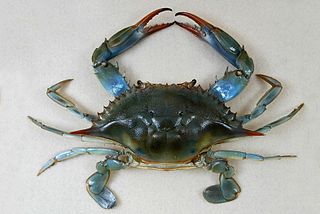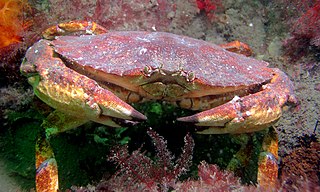
Nemertea is a phylum of animals also known as ribbon worms or proboscis worms. Most ribbon worms are very slim, usually only a few millimeters wide, although a few have relatively short but wide bodies. Many have patterns of yellow, orange, red and green coloration. The foregut, stomach and intestine run a little below the midline of the body, the anus is at the tip of the tail, and the mouth is under the front. A little above the gut is the rhynchocoel, a cavity which mostly runs above the midline and ends a little short of the rear of the body. All species have a proboscis which lies in the rhynchocoel when inactive but everts to emerge just above the mouth to capture the animal's prey with venom. A highly extensible muscle in the back of the rhynchocoel pulls the proboscis in when an attack ends. A few species with stubby bodies filter feed and have suckers at the front and back ends, with which they attach to a host.

Callinectes sapidus, the blue crab, Atlantic blue crab, or regionally as the Chesapeake blue crab, is a species of crab native to the waters of the western Atlantic Ocean and the Gulf of Mexico, and introduced internationally.

The Dungeness crab is a species of crab inhabiting eelgrass beds and water bottoms along the west coast of North America. It typically grows to 20 cm (7.9 in) across the carapace and is a popular seafood. Its common name comes from Dungeness Spit, United States, which shelters a shallow bay inhabited by the crabs.

The Florida stone crab is a crab found in the western North Atlantic, from Connecticut to Belize, including Texas, the Gulf of Mexico, Cuba, The Bahamas, and the East Coast of the United States. The crab can also be found in and around the salt marshes of South Carolina and Georgia. It is widely caught for food. The closely related species Menippe adina is sometimes considered a subspecies – they can interbreed, forming hybrids – and they are treated as one species for commercial fishing, with their ranges partly overlapping. The two species are believed to have diverged approximately 3 million years ago.

Carcinus maenas is a common littoral crab. It is known by different names around the world. In the British Isles, it is generally referred to as the shore crab, or green shore crab. In North America and South Africa, it bears the name european green crab.

Metacarcinus anthonyi, the yellow rock crab or yellow crab, is a species of edible crab native to the Pacific coast of North America.

The graceful rock crab or slender crab, Metacarcinus gracilis or Cancer gracilis, is one of only two members of the genus Metacarcinus, recognized by WoRMS, whose chelae (claws) are white tipped, the other crab being M. magister. Both of these eastern Pacific crab species are recognized by ITIS as belonging to the much larger genus Cancer. M. gracilis has been caught from Alaska to Bahía Magdelena, Baja California. Although M. gracilis is only found in the Pacific Ocean, it has cousins in the Atlantic Ocean. The genus Cancer apparently evolved in the Pacific Ocean and later migrated to the Atlantic Ocean. Larvae and small juveniles of this species are often seen riding jellyfish, especially Phacellophora camtschatica. The juvenile crabs steal food from the jellyfish and also clean off parasitic amphipods.

Enopla is one of the classes of the worm phylum Nemertea, characterized by the presence of a peculiar armature of spines or plates in the proboscis.
Marine larval ecology is the study of the factors influencing dispersing larvae, which many marine invertebrates and fishes have. Marine animals with a larva typically release many larvae into the water column, where the larvae develop before metamorphosing into adults.

Cancer productus, one of several species known as red rock crabs, is a crab of the genus Cancer found on the western coast of North America. This species is commonly nicknamed the Pearl of the Pacific Northwest.

Marine invertebrates are the invertebrates that live in marine habitats. Invertebrate is a blanket term that includes all animals apart from the vertebrate members of the chordate phylum. Invertebrates lack a vertebral column, and some have evolved a shell or a hard exoskeleton. As on land and in the air, marine invertebrates have a large variety of body plans, and have been categorised into over 30 phyla. They make up most of the macroscopic life in the oceans.

Diodora aspera, also known as the rough keyhole limpet, is a species of sea snail, a marine gastropod mollusk in the family Fissurellidae, the keyhole limpets. Although similar in appearance to a common limpet, it has a hole near the apex of its shell, and is only distantly related. It often has a scaled polychaete worm Arctonoe vittata living inside its shell as a commensal. In the event that it is attacked by a starfish, it extends flaps of mantle to defend itself, and the worm also helps drive the predator away.
Pinnixa chaetopterana, the tube pea crab, is a small decapod crustacean that lives harmlessly within the tube of the polychaete worm, Chaetopterus variopedatus.

Emerita analoga, the Pacific sand crab or Pacific mole crab, is a species of small, sand-burrowing decapod crustacean found living in the sand along the temperate western coasts of North and South America. It is found on exposed sandy beaches in the swash region of the intertidal zone.

Loxorhynchus grandis, commonly known as the sheep crab or spider crab, is a species of crab in the family Epialtidae. It is the largest crab found on the California coast. The species was first described to science by William Stimpson in 1857. The type specimen was collected on the coast of California, near San Francisco. Fossils from the late Miocene epoch indicate that this species is at least 11.63 to 5.333 million years old.
Listriolobus pelodes is a species of marine spoon worm. It is found in shallow seas in the North East Pacific off the coast of California. It lives in a burrow in soft sediments.

Kelletia kelletii, common name Kellet's whelk, is a species of large sea snail, a whelk, a marine gastropod mollusc in the family Buccinidae, the true whelks.
Petrolisthes armatus, the green porcelain crab, is a species of small porcelain crab in the family Porcellanidae. It is believed to be native to Brazil but has spread to other parts of the world. Populations in the south eastern part of the United States have increased dramatically and the species is considered to be an invasive species.

Crustaceans form a large, diverse arthropod taxon which includes such animals as decapods, seed shrimp, branchiopods, fish lice, krill, remipedes, isopods, barnacles, copepods, amphipods and mantis shrimp. The crustacean group can be treated as a subphylum under the clade Mandibulata. It is now well accepted that the hexapods emerged deep in the Crustacean group, with the completed group referred to as Pancrustacea. Some crustaceans are more closely related to insects and the other hexapods than they are to certain other crustaceans.

Lithodes aequispinus, the golden king crab, also known as the brown king crab, is a king crab species native to the North Pacific. Golden king crabs are primarily found in the Aleutian Islands and waters nearer to Alaska and British Columbia; their range also extends to the Russian far east and Japan, albeit with a less dense population. Golden king crabs are the smallest of the three commercially viable Alaskan king crab species with an average weight between 5 and 8 lbs(2.3 - 3.6 kg); the other two species being the blue and red king crabs. Golden king crabs were historically caught incidentally in red king crab fisheries, but the first commercial landing took place in 1975; in 1981, the targeted pot-fishing method, a hybrid fishing method specifically for golden king crab, was developed.















